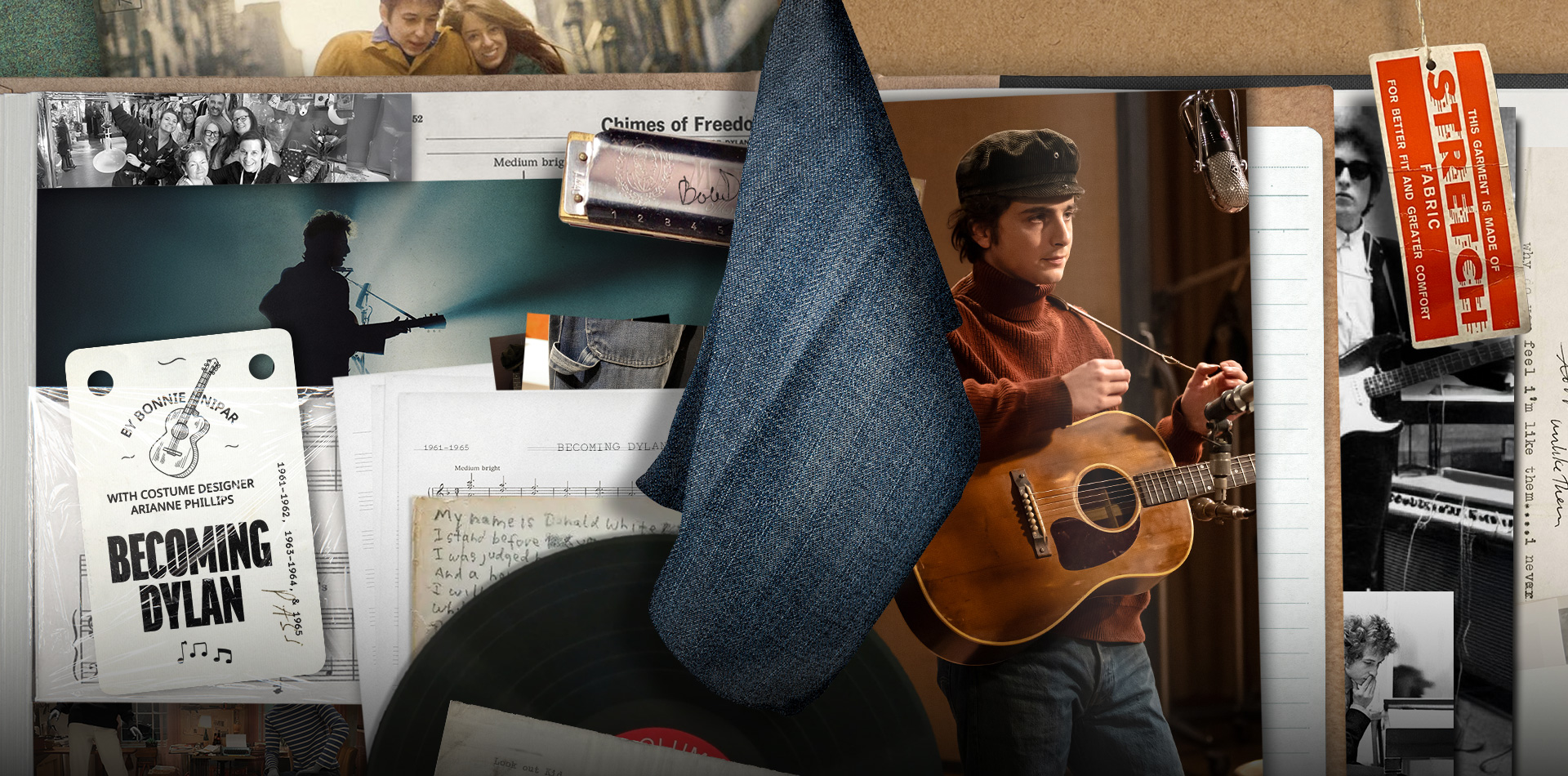By Bonnie Nipar | February 7, 2024
Becoming Dylan: Arianne Phillips
The only singer-songwriter to receive a Nobel Prize in Literature, Bob Dylan has long been a guiding voice in American culture. Now his legendary music narrates the story of his most turbulent years in A Complete Unknown. Costume designer Arianne Phillips is exceptionally diverse in what she chooses to design. Film, television, Broadway, music videos, and tours—she’s done it all. Working closely with production designer François Audouy, the results are so authentic you can almost smell the gritty streets of New York City.
BN
How did you begin to cover these four transformative years of Bob Dylan’s life?
AP
I aspire to underscore what’s emotionally happening, to be sensitive to the way director James Mangold frames his scenes, and how I can support that with costumes. Jim first asked me to design this film in 2019. Then we shut down for COVID and didn’t start filming until late May 2023. That afforded me time to leisurely research, aggregate images, and read biographies. Once back, Jim and I, along with hair and makeup—Jaime Leigh McIntosh and Stacey Panepinto—decided we should approach the project as a three-part arc: 1961£62, 1963£64, and 1965
BN
How did you transform Timothée Chalamet to become Dylan so organically?
AP
This film is about Dylan finding his way as an artist, and that is best expressed through his denim, his boots, and his hair. Nineteen-year-old Dylan came from Minneapolis to New York looking for his folk hero Woody Guthrie. He dressed in a quintessentially American style in Pendleton shirts, dungaree painter pants, and tan work boots. We custom-made his corduroy car coat based on one from the late ’50s, adding trim at collar and cuffs, a hand-knit wool scarf, and a proletariat cap. The second beat would be 1963£64. His hair is a bit longer and his silhouette less baggy, as encapsulated best on The Freewheelin’’ album cover. Bob wore denim consistently, something we take for granted now. Noticing his 501s, I immediately reached out to Paul O’Neill, the head designer at Levi’s vintage department. They recreated the 1963 version from their archives. Dylan’s girlfriend made denim inserts on the inside of his bootlegs to fit over his cowboy and roughout boots. Once I read that, I couldn’t un-see it. It was really thrilling to be able to recreate that in the jeans.
BN
When Dylan transitions to electric guitar at the Newport Folk Festival in 1965, there’s a big shift for the third arc. How did you implement that?
AP
I had already researched this era 20 years ago when I designed Walk the Line for Jim. I was intrigued by the unexpected friendship between Johnny Cash and Bob Dylan. Johnny served as a beacon for Bob in terms of a singular artist who didn’t kowtow to what executives told him to do. He inspired Bob’s evolution into his own style. The band had made a recent tour in London where he was influenced by the Mod look. His hair is even longer, and his wardrobe now included a military style peacoat with epaulets, a black leather jacket, black Chelsea boots, and the skinny Mod jean that Levi’s only made for two years and recreated for us. As an artist, Dylan has always demanded the freedom to be diverse in his music, and that’s reflected in his style.
BN
The festival scenes alone must have been challenging.
AP
It was a big picture to paint. Timmy had 67 changes. We had 120 speaking parts; the first 20 on the call sheet had a minimum of 10 changes, and some had up to 20. The amount of stock we needed to costume 5,000 background actors, half with two changes, was daunting. Altogether, we had about 7,500 costumes on extras. Huge thanks to my ACDs Felicia Jarvis, Katie Hartsoe, and Amanda Seymour, and my illustrator, Eduardo Lucero. They were invaluable.
BN
How did you keep it all straight?
AP
The schedule was short and ambitious. In one day we could bounce from ’61 to ’62 to ’65, and then back to ’63. I created a big costume bible with the trajectory of our story and visual research, then mini digital bibles for each principal actor alongside the fitting photo, which we replaced with continuity photos from the set. I also talked to my actors the night before shooting so they knew what they would be wearing. There are euphoric moments in costume design where the character comes together from the costumes. That’s what keeps me coming back.



